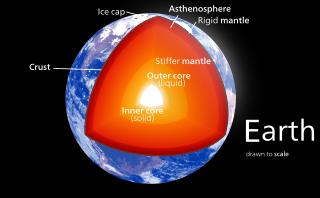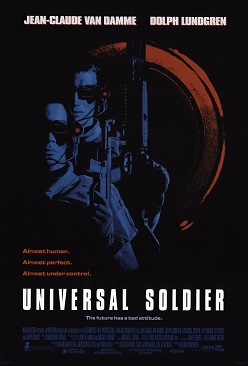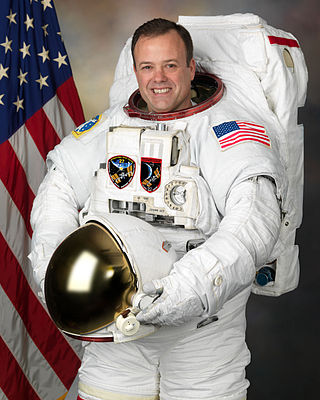
Plate tectonics is the scientific theory that Earth's lithosphere comprises a number of large tectonic plates, which have been slowly moving since about 3.4 billion years ago. The model builds on the concept of continental drift, an idea developed during the first decades of the 20th century. Plate tectonics came to be accepted by geoscientists after seafloor spreading was validated in the mid-to-late 1960s.

Europa, or Jupiter II, is the smallest of the four Galilean moons orbiting Jupiter, and the sixth-closest to the planet of all the 95 known moons of Jupiter. It is also the sixth-largest moon in the Solar System. Europa was discovered independently by Simon Marius and Galileo Galilei and was named after Europa, the Phoenician mother of King Minos of Crete and lover of Zeus.

The climate of Antarctica is the coldest on Earth. The continent is also extremely dry, averaging 166 mm (6.5 in) of precipitation per year. Snow rarely melts on most parts of the continent, and, after being compressed, becomes the glacier ice that makes up the ice sheet. Weather fronts rarely penetrate far into the continent, because of the katabatic winds. Most of Antarctica has an ice-cap climate with extremely cold and dry weather.

The Corona program was a series of American strategic reconnaissance satellites produced and operated by the Central Intelligence Agency (CIA) Directorate of Science & Technology with substantial assistance from the U.S. Air Force. The CORONA satellites were used for photographic surveillance of the Soviet Union (USSR), China, and other areas beginning in June 1959 and ending in May 1972.

The Day After Tomorrow is a 2004 American science fiction disaster film conceived, co-written, co-produced, and directed by Roland Emmerich, based on the 1999 book The Coming Global Superstorm by Art Bell and Whitley Strieber, and starring Dennis Quaid, Jake Gyllenhaal, Sela Ward, Emmy Rossum, and Ian Holm. The film depicts catastrophic climatic effects following the disruption of the North Atlantic Ocean circulation, in which a series of extreme weather events usher in climate change and lead to a new ice age.

Roland Emmerich is a German film director, screenwriter, and producer. He is widely known for his science fiction and disaster films and has been called a "master of disaster" within the industry. His films, most of which are English-language Hollywood productions, have made more than $3 billion worldwide, including just over $1 billion in the United States, making him the country's 17th-highest-grossing director of all time.

Earth's mantle is a layer of silicate rock between the crust and the outer core. It has a mass of 4.01×1024 kg (8.84×1024 lb) and makes up 67% of the mass of Earth. It has a thickness of 2,900 kilometers (1,800 mi) making up about 46% of Earth's radius and 84% of Earth's volume. It is predominantly solid but, on geologic time scales, it behaves as a viscous fluid, sometimes described as having the consistency of caramel. Partial melting of the mantle at mid-ocean ridges produces oceanic crust, and partial melting of the mantle at subduction zones produces continental crust.

Patrick Joseph Wilson is an American actor. He began his career in 1995, starring in Broadway musicals. He received nominations for two Tony Awards for his roles in The Full Monty (2000–2001) and Oklahoma! (2002). He co-starred in the acclaimed HBO miniseries Angels in America (2003), for which he was nominated for a Golden Globe Award and a Primetime Emmy Award.

Me and You and Everyone We Know is a 2005 American romantic comedy-drama film written and directed by Miranda July. She also acts in the starring role, opposite John Hawkes. The film was the first major studio production for July, who had been known previously for her self-produced short films and performance art.

Fingerprints of the Gods: The Evidence of Earth's Lost Civilization is a 1995 pseudoarcheology book by British writer Graham Hancock, which contends that an advanced civilization existed in prehistory, one which served as the common progenitor civilization to all subsequent known ancient historical ones. The author proposes that sometime around the end of the last ice age this civilization ended in cataclysm, but passed on to its inheritors profound knowledge of such things as astronomy, architecture and mathematics.

Moon 44 is a 1990 English-language German science fiction action film from Centropolis Film Productions, directed by Roland Emmerich and starring Michael Paré and Lisa Eichhorn alongside Brian Thompson and Malcolm McDowell. The film is set on a futuristic mining site on Moon 44, where convicts and teenage technicians are partnered. An undercover agent (Paré) must discover what has happened to missing corporate shuttles.

Universal Soldier is a 1992 American military science-fiction action film directed by Roland Emmerich, produced by Allen Shapiro, Craig Baumgarten, and Joel B. Michaels, and written by Richard Rothstein, Christopher Leitch, and Dean Devlin. The film tells the story of Luc Deveraux, portrayed by Jean-Claude Van Damme, a former U.S. Army soldier who was killed in the Vietnam War in 1969, and returned to life following a secret military project called the "Universal Soldier" program. However, he finds out about his past, though his memory was erased, and escapes alongside a young TV journalist. Along the way, they have to deal with the return of his archenemy, Sgt. Andrew Scott, who had lost his sanity in the Vietnam War, and became a psychotic megalomaniac, intent on killing him and leading the Universal Soldiers.
The comic book stories published by Marvel Comics since the 1940s have featured several noteworthy concepts besides its fictional characters, such as unique places and artifacts. There follows a list of those features.

Ronald John Garan Jr. is a retired NASA astronaut. After graduating from State University of New York College at Oneonta in 1982, he joined the Air Force, becoming a Second Lieutenant in 1984. He became an F-16 pilot, and flew combat missions in Desert Shield and Desert Storm. Before becoming an astronaut he was the Operations Officer of the 40th Flight Test Squadron (FTS). He first flew in space as a mission specialist on the May 2008 STS-124 mission to the International Space Station (ISS). He returned to ISS on April 4, 2011, for a six-month stay as a member of Expedition 27. Garan is a highly decorated former NASA astronaut who flew on the US Space Shuttle, Russian Soyuz, and International Space Station. In total he spent 178 days in space and more than 71 million miles in 2,842 orbits of Earth, 27 hours and 3 minutes of EVA in four spacewalks, and 18 days on the bottom of the ocean during the NEEMO-9 undersea mission.
Extraterrestrial liquid water is water in its liquid state that naturally occurs outside Earth. It is a subject of wide interest because it is recognized as one of the key prerequisites for life as we know it and is thus surmised to be essential for extraterrestrial life.

Joey, also known as Making Contact, is a 1985 West German techno-horror-fantasy film from Centropolis Film Productions. The film was co-written and directed by Roland Emmerich.

2012 is a 2009 American epic science fiction disaster film directed by Roland Emmerich, written by Emmerich and Harald Kloser, and stars John Cusack, Amanda Peet, Chiwetel Ejiofor, Oliver Platt, Thandiwe Newton, Danny Glover and Woody Harrelson. Based on the 2012 phenomenon, its plot follows geologist Adrian Helmsley (Ejiofor) and novelist Jackson Curtis (Cusack) as they struggle to survive an eschatological sequence of events including earthquakes, volcanic eruptions, megatsunamis, and a global flood.

Titanic II is a 2010 American drama disaster film written, directed by and starring Shane Van Dyke and distributed by The Asylum. Despite the title, it is not a sequel to the 1997 critically acclaimed film, but is a mockbuster of it. It was released direct-to-TV in Australia on 7 August 2010. It premiered on Syfy, on Sky in the UK and Ireland on 9 August. It was released on 25 August in the United States to critically negative response, though the film's ensemble cast performances, particularly that of Bruce Davison, received praise.

Independence Day: Resurgence is a 2016 American science fiction disaster film co-written, directed and co-produced by Roland Emmerich and co-written and co-produced by Dean Devlin, serving as a sequel to Independence Day (1996). It stars an ensemble cast that consists of Liam Hemsworth, Jeff Goldblum, Bill Pullman, Maika Monroe, Travis Tope, William Fichtner, Charlotte Gainsbourg, and Judd Hirsch. The film takes place twenty years after the events of the first film, during which the United Nations has collaborated to form the Earth Space Defense, an international military defense and research organization. Through reverse engineering, the world has fused the power of alien technology with humanity's and laid the groundwork to resist a second invasion.

Moonfall is a 2022 science fiction disaster film co-written, directed, and produced by Roland Emmerich. It stars Halle Berry, Patrick Wilson, John Bradley, Michael Peña, Charlie Plummer, Kelly Yu, Carolina Bartczak, and Donald Sutherland. It follows two former astronauts alongside a conspiracy theorist who discover the hidden truth about the Moon when it suddenly leaves its orbit. Shot in Montreal on a $138–146 million budget, it is one of the most expensive independently produced films ever made.


















